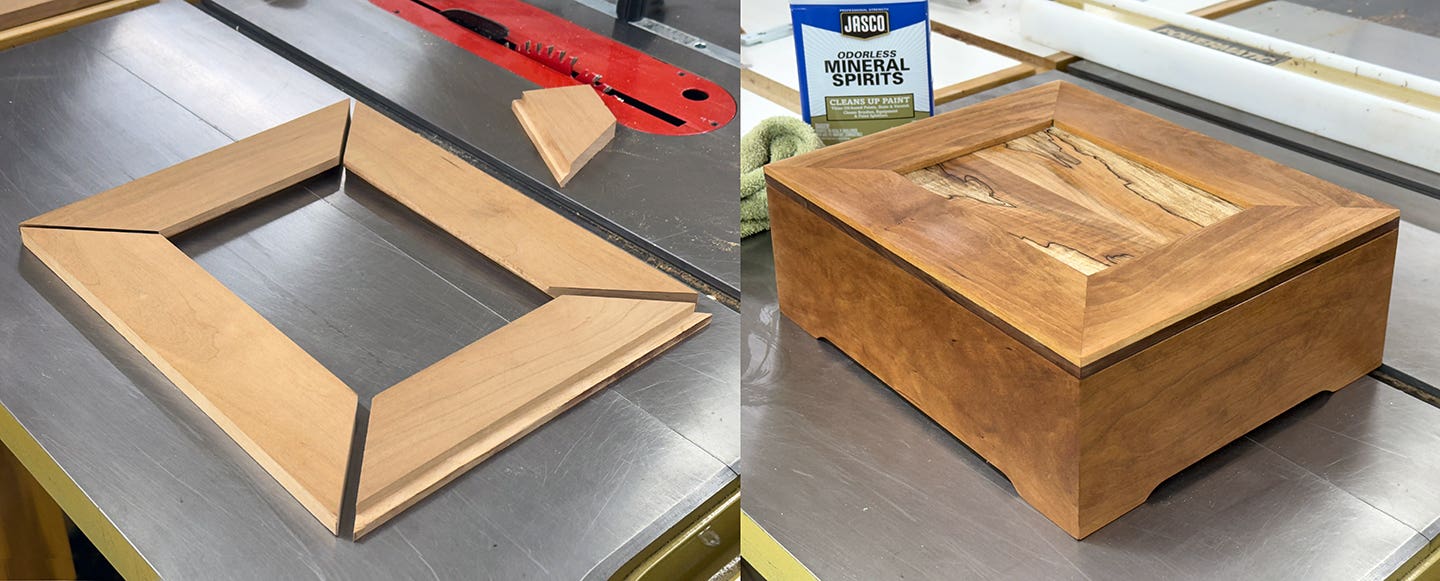Joining an organization can give you a leg up
Every industry has its share of professional organizations and the woodworking industry is no exception. Is it worth joining one? The answer is definitely yes, but with some provisos. The…
Every industry has its share of professional organizations and the woodworking industry is no exception. Is it worth joining one?
The answer is definitely yes, but with some provisos. The key is to ask what the organization can do. For big shops with lots of employees, association benefits range from trade show exposure to management consulting. For one-man shops, membership can lead to word-of-mouth marketing, new skills and even insurance discounts. The downsides can include minor competition issues, the cost of membership fees and sometimes a time commitment. But these are almost universally offset by gains.
One of the oldest and most respected trade associations for millwork, furniture and casework shops is the Architectural Woodwork Institute. This venerable organization has been around since the 1950s, but it has earlier roots in the Millwork Cost Bureau, a trade association of custom millwork operators founded in 1914. Today, AWI represents nearly 4,000 members consisting of architectural woodworkers, suppliers, design professionals and students from around the world.
The current cost of membership begins at $600 and is based on a shop’s gross annual sales. Benefits of membership include listing in the Resource Directory, use of the AWI logo, a host of education resources, access to several must-have publications including the industry-changing Architectural Woodwork Standards handbook, local chapters and shop visits, and a high level of networking across the industry. AWI also offers Design Solutions magazine to its members, an estimating cost book, an installation manual for millwork, a guide to cabinet fabrication and the results of a comprehensive survey on the cost of doing business in this market.
One organization that shop owners and managers might want to seriously consider joining is the non-profit WoodLINKS USA. Anticipating the current shortage of skilled workers entering our industry, this organization was established as a partnership between woodshops and both secondary and post-secondary woodworking programs. It helps to build and maintain a strong, skilled workforce so that U.S. manufacturers can remain competitive. It is comprised of two staff members, three volunteer directors, 13 board members and hundreds of national volunteers who have a passion for the wood industry and wood education. Owners, managers and skilled woodshop staff can get involved on many different levels. The benefits include helping to mold the future of the industry, providing our shops with trained workers, improving the lives of lots of young people and creating a strong bond between our industry and the educators who support it.
Common bonds
The American Society of Furniture Designers was founded in 1981 and is “the only international non-profit professional organization dedicated to advancing, improving and supporting the profession of furniture design and its positive impact in the marketplace.” Its members specialize in the design of both residential and contract furnishings and accessories and include both American and international designers, teachers and students. Along the same lines, The Furniture Society is a non-profit, educational organization founded in 1996. Its mission is “to advance the art of furniture making by inspiring creativity, promoting excellence and fostering an understanding of this art and its place in society.”
The Association of Closet and Storage Professionals offers designer certification in this field and a number of marketing benefits including an online search engine that can be used by interior designers or homeowners to find a specialist who has completed their program.
With a pedigree stretching back to the 1930s, the Association of Millwork Distributors brings together millwork distributors, manufacturers of products and services and sales representatives through annual meetings, leadership and education conferences, conventions and trade shows and through its member committees, advocate groups and a LinkedIn community.
The Cabinet Makers Association is a professional organization where cabinetmakers and woodworkers from both the residential and commercial markets get together and share their hard-earned knowledge and experience to help one another. The CMA doesn’t look at woodshops as competition. Rather, it believes that “working together is the best way to improve our own individual companies as well as the industry as a whole.” Members enjoy discounts at major woodworking shows, industry educational seminars and other industry events. The CMA also offers their “Shop Finder” service to potential clients. The association also provides professional certification that lends an air of trust and confidence to a business, uses the Wood Diamond Awards program to enhance shops’ reputations and offers peer-to-peer networking online. The network offers extraordinary access to the accumulated knowledge and experience of other woodworking business owners.
One example of how this works is that you might find yourself in need of, say, some CNC programming assistance on a weekend with a deadline looming and one of your fellow members will usually be willing to give you some answers and shortcuts. The CMA also provides a quarterly magazine, a monthly e-newsletter, access to a list of members, representation at industry and policy venues and a presence in the industry press. The annual membership fee for general members is currently $275.
Industry groups
The Kitchen Cabinet Manufacturers Association is a voluntary, non-profit trade association representing North American cabinet manufacturers and suppliers to the industry. The association is an influential advocate for the industry and since 1955 has “administered nationally recognized performance standard for cabinets (ANSI/KCMA A161.1). Today, the association is also leading the way in promoting responsible environment practices in the industry.” Membership benefits include legislative and regulatory updates; surveys that help with business planning; plant tours and other educational programs; a voluntary testing and certification program for cabinets; an environmental stewardship program, and member visibility through its website.
The National Association of Home Builders and the National Association of the Remodeling Industry are great resources for woodshop, especially when one considers the strong relationship between our products and housing starts.
The National Hardwood Lumber Association was founded in 1898 to “establish a uniform system of grading rules for the measurement and inspection of hardwood lumber. Since then the group has taken on the role of educator, whose mission is to provide the industry with the training it needs to succeed in a changing and global economy.” While its original focus was as a support system for some of our most valuable suppliers, the association now has a great deal to offer woodworkers, too, including education on grading and a host of information channels including Hardwood Matters magazine, the monthly e-newsletter Hardwire and, of course, its website. These media resources can help keep shops informed on issues such as ash borers and other dangers or perhaps the resurgence of species like chestnut and elm.
The National Kitchen and Bath Association offers several benefits to its members, including access to consumer leads, the credibility of its logo, ad templates and business forms, local chapter meetings, member discounts, industry job boards and professional certification. And the Wood Component Manufacturers Association makes it easy for buyers to find members that can produce components in both solid and engineered wood materials. The WCMA also exhibits at no fewer than six domestic and international trade shows each year with displays highlighting the various products produced by WCMA member companies.
Membership benefits of the Wood Products Manufacturers Association include an insurance program, a discount on FSC certification, newsletters, a sourcing directory, credit checks and an online “items for sale” page that’s quite interesting.
Online and local options
For very small shops, there are several free (and mostly online) groups such as the Modern Woodworkers’ Association that offer local chapter meetings, educational opportunities at woodworking shows and their popular online podcasts that are essentially small radio shows featuring some very interesting guests.
A similar online community for woodworkers, especially those who are into old tools, is Vintagemachinery.org. Thanks to Twitter and Facebook, such organizations now have a chance to survive and grow in their service to the woodshop community. As membership is free and nobody is asking for volunteer hours, there doesn’t seem to be any downside to membership.
Local woodworking clubs, especially organizations such as the American Association of Woodturners (more than 13,000 members) are a great way to become part of a local community, as many of the members are either business owners or managers or are newly retired from businesses where they are still in a position to influence buying decisions.
AWFS and IWF
One can’t discuss associations in the woodshop world without mentioning two of the biggest organizations that serve our industry. The Association of Woodworking & Furnishings Suppliers is best known because of its biennial fair, which will take place July 24-27 at the Las Vegas Convention Center in Nevada. This international organization includes manufacturers and distributors of machines, hardware, lumber, upholstery materials, bedding, wood products and other suppliers to furniture and cabinet manufacturers. It also welcomes educational institutes and non-profits (but not woodshops) as members. If you supply other shops with, for example, outsourced components, then you’re eligible for membership. For shops interested in lean manufacturing, this year’s fair seminars are heavily flavored in that area. Other subjects being tackled are design/CAD, CNC, finishes, estimating, going green/LEED and a host of practical classes such as incorporating marquetry and vacuum forming. The fair seminars have special programs for shop teachers, custom furniture builders, and a section specifically for small shops with fewer than ten employees.
Another venue, even bigger than the AWFS fair, is the International Woodworking Machinery & Furniture Supply’s show. This is the largest woodworking machinery and supply show in North America and the second largest in the world. It is held in even-numbered years in Atlanta. The hosts are the Wood Machinery Manufacturers of America Association and the Woodworking Machinery industry Association. Woodshops looking to improve any aspect of production, including machinery upgrades, can visit with every major manufacturer under one roof and comparison shop for four days every other year. The next IWF is scheduled for Aug. 20-23, 2014, at the Georgia World Congress Center in Atlanta.
This article originally appeared in the June 2013 issue.







